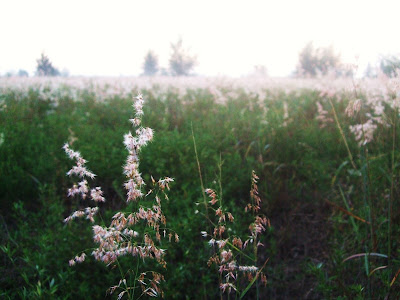Lovingly called the "Lost Coast", this coast in Changi East is relatively undisturbed by humans, and is probably one of the rare sites in Singapore unknown to many. Perhaps because of this ignorance of its existence, the lost coast stands a marvel, and I am one of the lucky few to have set foot on it and seen its pristine beauty.
Travis, Grace and I visited this coast on 30th June 2010, 5 days after the Oil Spill at Changi East, to check out how this coast is doing post-oil spill. With fingers tightly crossed, we hoped for the best, though we were expecting the worst.
As usual, the coast never fails to impress us with its beauty. As we bashed through mean, prickly undergrowths, nature rewarded our patience with amazing sights. First, the gorgeous mist overhanging the lalang grasses Melenis repens (Thanks Joseph Lai for the correction!):

The Melenis repens were in bloom with flowers decked out in soft pink:


As we reached the shore, we were presented a flamboyant show of sunrise:
Isn't nature at its best without any human infrastructure in sight (eg. buildings)?

However to our dismay, these have somehow managed to find their way here. A huge driftnet: a menace to living critters as it traps unsuspecting creatures. Once caught, these creatures often struggle to get out and the more they struggle the more entangled they get; eventually they use up their energy and without food they die and rot in these nets.

We wondered how these got here.
Fortunately, signs and sights of life were aplenty. Tracks or disturbances in the sand indicated the presence of visitors before us.

Ghost crab burrows

Ghost crab tracks

Imprints made by birds
I have no idea who made these tracks though; looks like it could have been made by a skink or some kind of lizard, perhaps a small Water monitor lizard?



Dog paw imprints

Sand balls made by Sand bubbler crabs as they feed
Not forgetting the Sand dollars which are in abundance here:
Commonly seen were the Sand collars which are the egg masses of the Moon snail; quoting from Ria's wildsingapore webpage:
"It's alive! Although the collar feels hard, plasticky and appears dead, each collar can contain thousands of living eggs. When the eggs hatch, the collar disintegrates.
Thus, an intact collar has living snails in it! Please don't damage the sand collars."
Also commonly seen on our shores are the egg cases of the Melongena snail:
Other sightings made were of the Acorn worm...
Ghost crab, which was found patronising an empty Durian shell (how cute, a comical sight indeed!)...
and last but not least, the "star" of the day, a sand star (Astropecten sp.)!


Also one of the interesting finds of the trip was this curious looking skull, which my friend Arjun suggests could be an Ariidae (catfish) skull.


The underside.
Signs of impact by the oil spill were obvious; the following pictures document the impact:

Huge dead sea bass, with Grace for scale, which could have been affected by the oil spill.

Not escaping sight were also the prominent oily strandlines left behind when the tide subsided:
The brown regions indicated where the vegetation had been directly hit by the oil spill:
And more signs of the devastation brought by the oil spill:
As we made our way back inland we found a stranded Fireworm (Chloeia sp.) and my fingers were stained with grease after handling an oiled wooden stick to bring it nearer the shore.
Despite the contamination of this pristine coast with oil from the oil spill, apparently the impact from the oil spill was not as serious as we had expected. However my take is that the impact of the oil spill may in time prove to be much larger than we could presently imagine, hence we cannot in the meantime regard the aftermath of the oil spill as trivial.
I hope to visit this shore again soon to check on its situation, and pray that this wonderful shore is recovering.
On a side note, Grace penned a beautiful note after the visit to the coast, which was her first:
"When the sutures healed I went walking
to the edge of the ocean, that the muscles
would not atrophy. I had almost lost
my tongue, my head shaven, my wings
clipped. No-one could remember who I was.
As a child I teetered on tree-roots, rooted
among the rhu trees for their mathematical cones.
In my driftwood kingdom I was both queen and thrall.
I floated among flotsam and jetsam
the sea washed up to the reclaimed shore:
packets and plastic shards of indefinite half-life
printed in alien languages,
whispering alien things. The beach itself
was an alien thing, its shells and worms
consuming each other and pulsing. It too
Had come from somewhere else. Walking
along the sand I felt less and less out of place.
I began to collect the shells,
and they helped me remember:
one day, I shall be a shell of my self,
and that shell shall be ground down to sand,
and the sand become a beach,
and the beach... Well.
The sea giveth and giveth.
And taketh away."


























Hi Chun Fong,
ReplyDeletejust to share: your pink-flowered grass is Melinis repens, not lalang.
see http://www.eart-h.com/text/melire.htm
cheers
Hi Joseph,
ReplyDeleteAppreciate your correction, thanks alot!
Cheers CF
Awesome post Chun and so good to see a new story on your blog. Some terrific photos too!
ReplyDeleteThat skull is a catfish skull and in North Queensland we call them cricifix skulls as when you look at the underside of the skull it looks a little like a crucifix.
Great story Chun and again great images!